Comparisons of Differential Filtering and Homography Transformation in Modal Parameter Identification from UAV Measurement
Abstract
:1. Introduction
1.1. Related Work
1.2. Contribution Summary of the Paper
2. Methods
2.1. DIC Method
2.2. UAV Image Correction
2.3. Differential Filtering
2.4. Operational Modal Analysis
3. Experiment
3.1. Experimental Setup and Instrument
- Digital camera (FASTCAM SA3, Photron Inc., Tokyo, Japan) for recording model vibration;
- DJI’s quadrotor drones (Spark, Da-Jiang Innovations, Shenzhen, China) with a high-resolution camera with a sampling frequency of 30 frames per second and a resolution of 1920 × 1080 pixels;
- A signal acquisition system for collecting signals (JM3840, Jing-Ming Technology Inc., Yangzhou, China);
- A laptop computer connected to the acquisition system.
3.2. Experiment Plan and Goal
- (a)
- Verifying the correction accuracy of the UAV results by comparing them with fixed cameras. The image sequence of the UAV is corrected by homography transformation to obtain the true displacement time-history signal, which is imported into the dynamic acquisition software with the time-history signal of the fixed camera to obtain the modal parameters. The results are compared with those of the fixed camera to demonstrate the feasibility of UAVs in actual vibration measurement.
- (b)
- Verifying the accuracy of the differential filtering method by comparing with homography-based correction results. The uncorrected time-history signals of UAV measurements are processed by the proposed differential filtering, and the processed results are input into the dynamic acquisition software to obtain the modal parameters, which are compared with those identified from the other two methods: accelerometer measurements and homography-based correction of UAV images.
4. Results
4.1. Measurement Results of UAV and Fixed Camera
4.2. Comparisons of the Processing Effects of Differential Filtering and Homography Transformation
4.3. Modal Parameters Identified from Differential Filtering, Homography Transformation and Accelerometer Measurements
5. Discussion and Conclusions
- (1)
- Under the same experimental conditions, UAVs can replace fixed cameras to accomplish data acquisition. The real-time history signals can be obtained after the homography transformation. Compared with accelerometer measurement, the DIC method is non-contact and full-field. More target points can be selected for measurement to improve the identification accuracy of mode shapes. Combination of the DIC technology with UAV measurement can greatly improve the efficiency of modal identification of real bridges.
- (2)
- Differential filtering is used to remove the zero drift and signal noise in UAV signals. Differential filtering can replace geometric correction for data processing and the modal parameters can be directly identified without obtaining the real structural displacement. Hence, differential filtering can greatly simplify modal identification from UAV measurement.
Author Contributions
Funding
Institutional Review Board Statement
Informed Consent Statement
Data Availability Statement
Conflicts of Interest
References
- Huang, Q.; Gardoni, P.; Hurlebaus, S. A probabilistic damage detection approach using vibration-based nondestructive testing. Struct. Saf. 2012, 38, 11–21. [Google Scholar] [CrossRef]
- Park, K.T.; Kim, S.H.; Park, H.S.; Lee, K.W. The determination of bridge displacement using measured acceleration. Eng. Struct. 2005, 27, 371–378. [Google Scholar] [CrossRef]
- Soyoz, S.; Feng, M.Q. Long-Term Monitoring and Identification of Bridge Structural Parameters. Comput.-Aided Civ. Infrastruct. Eng. 2010, 24, 82–92. [Google Scholar] [CrossRef]
- Nellen, P.M.; Anderegg, P.; Broennimann, R.; Sennhauser, U.J. Application of fiber optical and resistance strain gauges for long-term surveillance of civil engineering structures. In Smart Structures and Materials 1997: Smart Systems for Bridges, Structures, and Highways; International Society for Optics and Photonics: Bellingham, WA, USA, 1997. [Google Scholar]
- Xi, R.; Jiang, W.; Meng, X.; Chen, H.; Chen, Q. Bridge monitoring using BDS-RTK and GPS-RTK techniques. Measurement 2018, 120, 128–139. [Google Scholar] [CrossRef]
- Yi, T.H.; Li, H.N.; Gu, M. Experimental assessment of high-rate GPS receivers for deformation monitoring of bridge. Meas. J. Int. Meas. Confed. 2013, 46, 420–432. [Google Scholar] [CrossRef]
- Nassif, H.H.; Gindy, M.; Davis, J. Comparison of laser Doppler vibrometer with contact sensors for monitoring bridge deflection and vibration. NDT E Int. 2005, 38, 213–218. [Google Scholar] [CrossRef]
- Busca, G.; Cigada, A.; Mazzoleni, P.; Zappa, E. Vibration Monitoring of Multiple Bridge Points by Means of a Unique Vision-Based Measuring System. Exp. Mech. 2014, 54, 255–271. [Google Scholar] [CrossRef]
- Feng, D.; Feng, M.Q. Identification of structural stiffness and excitation forces in time domain using noncontact vision-based displacement measurement. J. Sound Vib. 2017, 406, 15–28. [Google Scholar] [CrossRef]
- Hild, F.; Roux, S. Digital Image Correlation: From Displacement Measurement to Identification of Elastic Properties—A Review. Strain 2010, 42, 69–80. [Google Scholar] [CrossRef] [Green Version]
- Pan, B.; Qian, K.; Xie, H.; Asundi, A. TOPICAL REVIEW: Two-dimensional digital image correlation for in-plane displacement and strain measurement: A review. Meas. Sci. Technol. 2009, 20, 152–154. [Google Scholar] [CrossRef]
- Malesa, M.; Malowany, K.; Tomczak, U.; Siwek, B.; Siemińska-Lewandowska, A. Application of 3D digital image correlation in maintenance and process control in industry. Comput. Ind. 2013, 64, 1301–1315. [Google Scholar] [CrossRef]
- Niu, Y.; Huang, H.; Zhang, J.; Jin, W.; Yu, Q. Development of the strain field along the crack in ultra-high-performance fiber-reinforced concrete (UHPFRC) under bending by digital image correlation technique. Cem. Concr. Res. 2019, 125, 105821. [Google Scholar] [CrossRef]
- Yoneyama, S.; Kitagawa, A.; Iwata, S.; Tani, K.; Kikuta, H. Bridge deflection measurement using digital image correlation. Exp. Tech. 2010, 31, 34–40. [Google Scholar] [CrossRef]
- Lee, J.J.; Shinozuka, M. Real-Time Displacement Measurement of a Flexible Bridge Using Digital Image Processing Techniques. Exp. Mech. 2006, 46, 105–114. [Google Scholar] [CrossRef]
- Liu, Y.; Nie, X.; Fan, J.; Liu, X. Image-based crack assessment of bridge piers using unmanned aerial vehicles and three-dimensional scene reconstruction. Comput.-Aided Civ. Infrastruct. Eng. 2019, 31, 511–529. [Google Scholar] [CrossRef]
- Angnuureng, D.B.; Almar, R.; Jayson-Quashigah, P.N.; Addo, K.A.; Anthony, E.J. Application of Shore-Based Video and Unmanned Aerial Vehicles (Drones): Complementary Tools for Beach Studies. Remote Sens. 2020, 12, 394. [Google Scholar] [CrossRef] [Green Version]
- Contreras-de-Villar, F.; García, F.; Muñoz-Perez, J.; Contreras-de-villar, A.; Ruiz-Ortiz, V.; Lopez, P.; Garcia-López, S.; Jigena, B. Beach Leveling Using a Remotely Piloted Aircraft System (RPAS): Problems and Solutions. J. Mar. Sci. Eng. 2021, 9, 19. [Google Scholar] [CrossRef]
- Burdziakowski, P.; Specht, C.; Dbrowski, P.S.; Specht, M.; Makar, A. Using UAV Photogrammetry to Analyse Changes in the Coastal Zone Based on the Sopot Tombolo (Salient) Measurement Project. Sensors 2020, 20, 4000. [Google Scholar] [CrossRef]
- Genchi, S.A.; Vitale, A.J.; Perillo, G.; Seitz, C.; Delrieux, C.A. Mapping Topobathymetry in a Shallow Tidal Environment Using Low-Cost Technology. Remote Sens. 2020, 12, 1394. [Google Scholar] [CrossRef]
- Lowe, M.K.; Adnan, F.; Hamylton, S.M.; Carvalho, R.C.; Woodroffe, C.D. Assessing Reef-Island Shoreline Change Using UAV-Derived Orthomosaics and Digital Surface Models. Drones 2019, 3, 44. [Google Scholar] [CrossRef] [Green Version]
- Rodríguez-Canosa, G.; Stephen, T.; Jaime, D.C.; Antonio, B.; Bruce, M. A Real-Time Method to Detect and Track Moving Objects (DATMO) from Unmanned Aerial Vehicles (UAVs) Using a Single Camera. Remote Sens. 2012, 4, 1090–1111. [Google Scholar] [CrossRef] [Green Version]
- Yoon, H.; Shin, J.; Spencer, B.F. Structural Displacement Measurement Using an Unmanned Aerial System. Comput.-Aided Civ. Infrastruct. Eng. 2018, 33, 183–192. [Google Scholar] [CrossRef]
- Ribeiro, D.S.R.; Cabral, R.; Saramago, G.; Montenegro, P.; Carvalho, H.; Correia, J.; Calçada, R. Calçada. Non-contact structural displacement measurement using Unmanned Aerial Vehicles and video-based systems—ScienceDirect. Mech. Syst. Signal Process. 2021, 160, 107869. [Google Scholar] [CrossRef]
- Hoskere, V.; Park, J.W.; Yoon, H.; Spencer, B.F., Jr. Vision-Based Modal Survey of Civil Infrastructure Using Unmanned Aerial Vehicles. J. Struct. Eng. 2019, 145. [Google Scholar] [CrossRef]
- Yoneyama, S.; Ueda, H. Bridge Deflection Measurement Using Digital Image Correlation with Camera Movement Correction. Mater. Trans. 2012, 53, 285–290. [Google Scholar] [CrossRef] [Green Version]
- Chen, G.; Liang, Q.; Zhong, W.; Gao, X.; Cui, F. Homography-based measurement of bridge vibration using UAV and DIC method. Measurement 2020, 170, 108683. [Google Scholar] [CrossRef]
- Wu, Z.; Chen, G.; Ding, Q.; Yuan, B.; Yang, X. Three-Dimensional Reconstruction-Based Vibration Measurement of Bridge Model Using UAVs. Appl. Sci. 2021, 11, 5111. [Google Scholar] [CrossRef]
- Zhu, X.; Chen, Z.; Tang, C.; Mi, Q.; Yan, X. Application of two oriented partial differential equation filtering models on speckle fringes with poor quality and their numerically fast algorithms. Appl. Opt. 2013, 52, 1814–1823. [Google Scholar] [CrossRef]
- Brownjohn, J.; Magalhaes, F.; Caetano, E.; Cunha, A. Ambient vibration re-testing and operational modal analysis of the Humber Bridge. Eng. Struct. 2010, 32, 2003–2018. [Google Scholar] [CrossRef] [Green Version]
- Zhang, Y.; Zhang, S.; Li, H.; Wen, B. Harmonic mode identification in the operational modal analysis and its application. Zhendong Ceshi Yu Zhenduan/J. Vib. Meas. Diagn. 2008, 28, 197–200. [Google Scholar]
- Reynders, E.; Roeck, G.D. Reference-based combined deterministic–stochastic subspace identification for experimental and operational modal analysis. Mech. Syst. Signal Process. 2008, 22, 617–637. [Google Scholar] [CrossRef]
- Yan, W.J.; Ren, W.X. An Enhanced Power Spectral Density Transmissibility (EPSDT) approach for operational modal analysis: Theoretical and experimental investigation. Eng. Struct. 2015, 102, 108–119. [Google Scholar] [CrossRef]
- Yan, W.J.; Ren, W.X. Operational Modal Parameter Identification from Power Spectrum Density Transmissibility. Comput.-Aided Civ. Infrastruct. Eng. 2012, 27, 202–217. [Google Scholar] [CrossRef]
- Sutton, M.A.; Cheng, M.; Peters, W.H.; Chao, Y.J.; Mcneill, S.R. Application of an optimized digital correlation method to planar deformation analysis. Image Vis. Comput. 1986, 4, 143–150. [Google Scholar] [CrossRef]
- Chu, T.C.; Ranson, W.F.; Sutton, M.A. Applications of digital-image-correlation techniques to experimental mechanics. Exp. Mech. 1985, 25, 232–244. [Google Scholar] [CrossRef]
- Mohanty, P.; Rixen, D.J. Identifying mode shapes and modal frequencies by operational modal analysis in the presence of harmonic excitation. Exp. Mech. 2005, 45, 213–220. [Google Scholar] [CrossRef]
- Wang, J.; Ye, Y.; Pan, X.; Gao, X. Parallel-type fractional zero-phase filtering for ECG signal denoising. Biomed. Signal Process. Control 2015, 18, 36–41. [Google Scholar] [CrossRef]
- De Vriendt, C.; Guillaume, P. The use of transmissibility measurements in output-only modal analysis. Mech. Syst. Signal Process. 2007, 21, 2689–2696. [Google Scholar] [CrossRef]
- Devriendt, C.; Guillaume, P. Identification of modal parameters from transmissibility measurements. J. Sound Vib. 2008, 314, 343–356. [Google Scholar] [CrossRef]
- Brincker, R.; Zhang, L.; Andersen, P. Modal identification of output only systems using Frequency Domain Decomposition. Smart Mater. Struct. 2001, 10, 441. [Google Scholar] [CrossRef] [Green Version]
- Pastor, M.; Binda, M.; Hararik, T. Modal Assurance Criterion. Procedia Eng. 2012, 48, 543–548. [Google Scholar] [CrossRef]
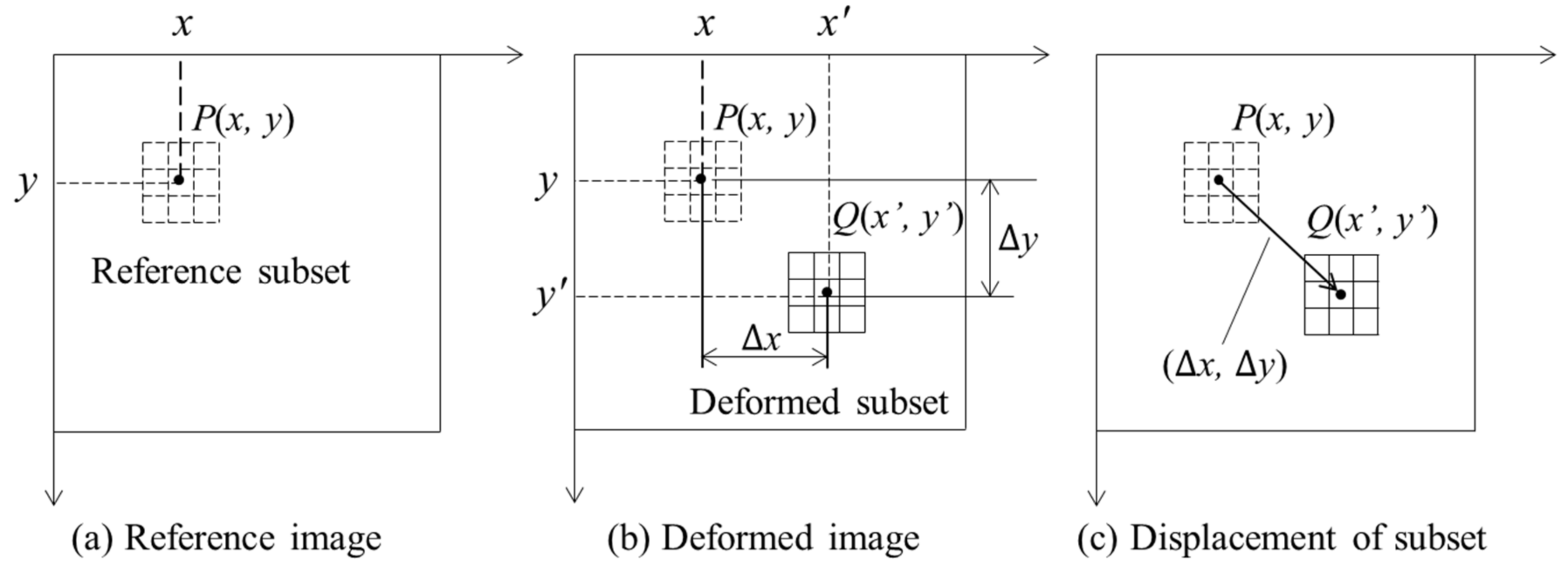

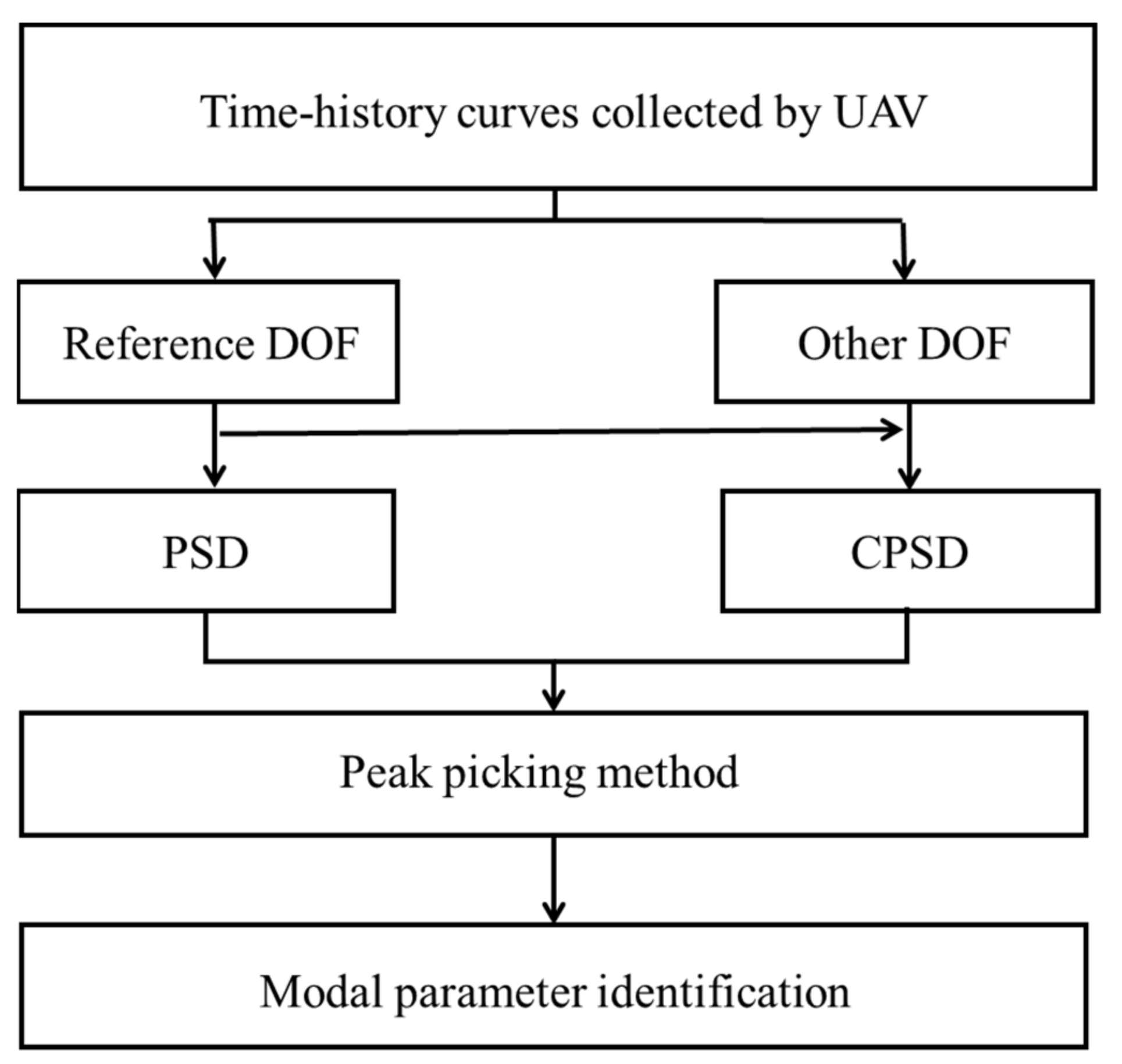
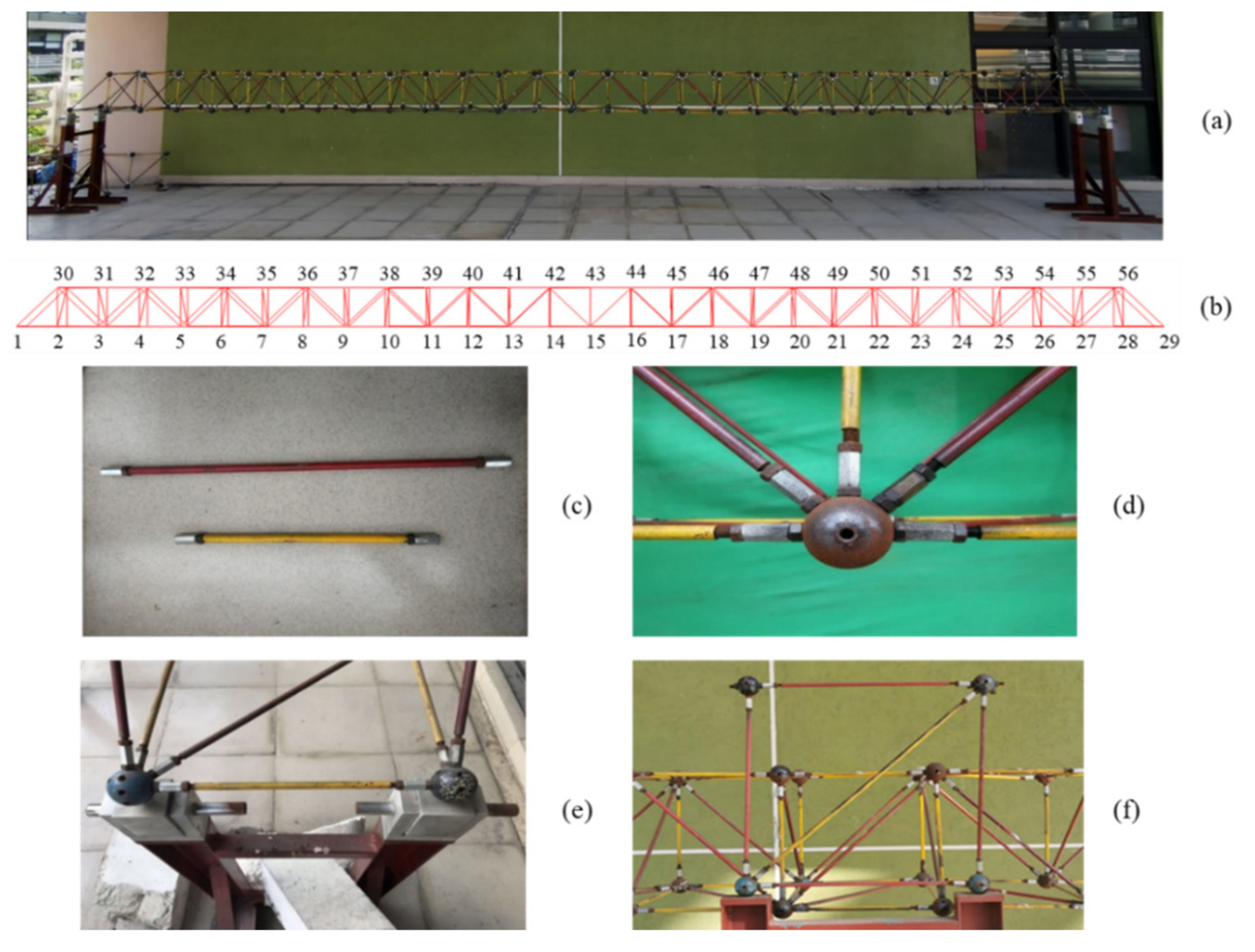
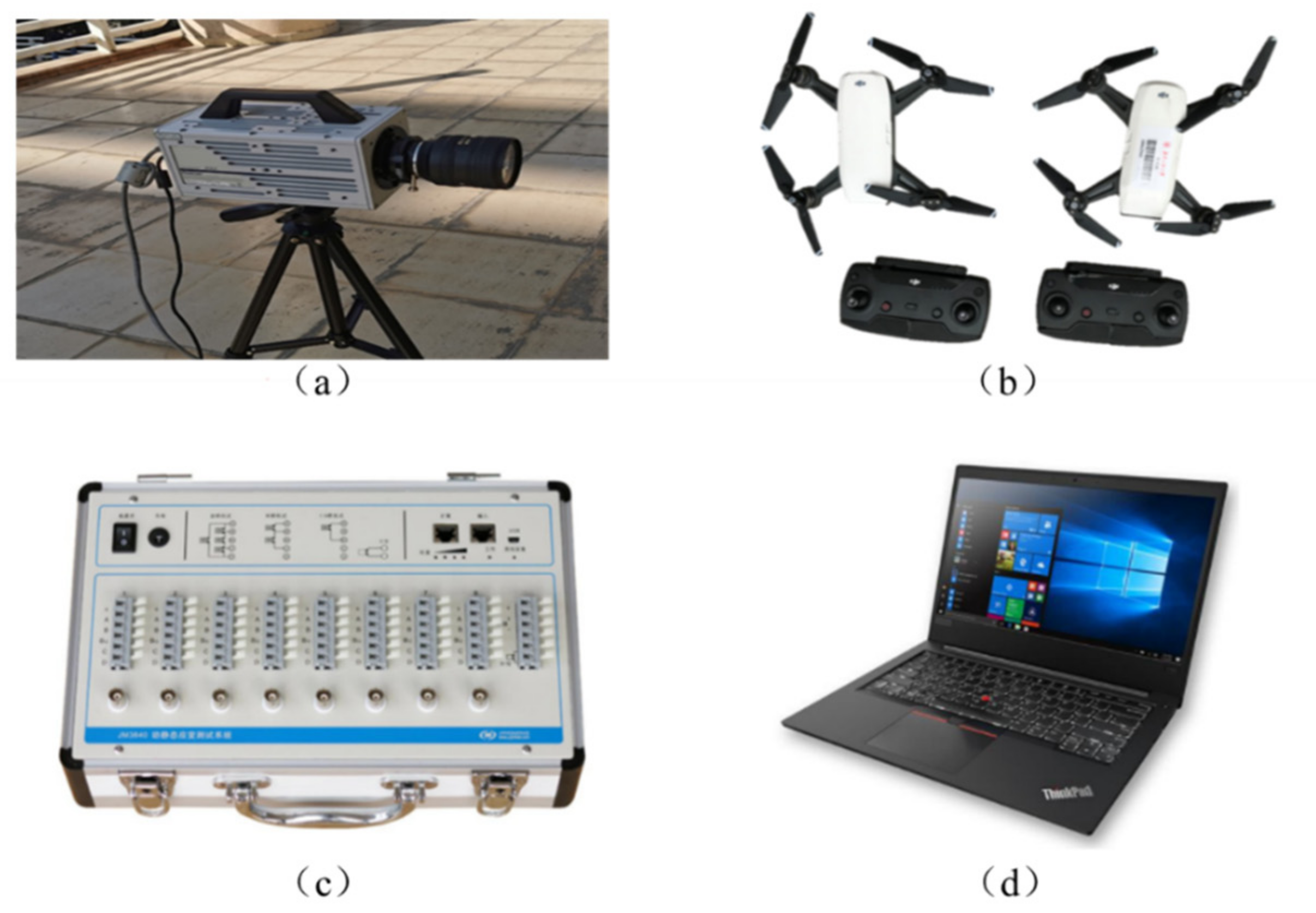

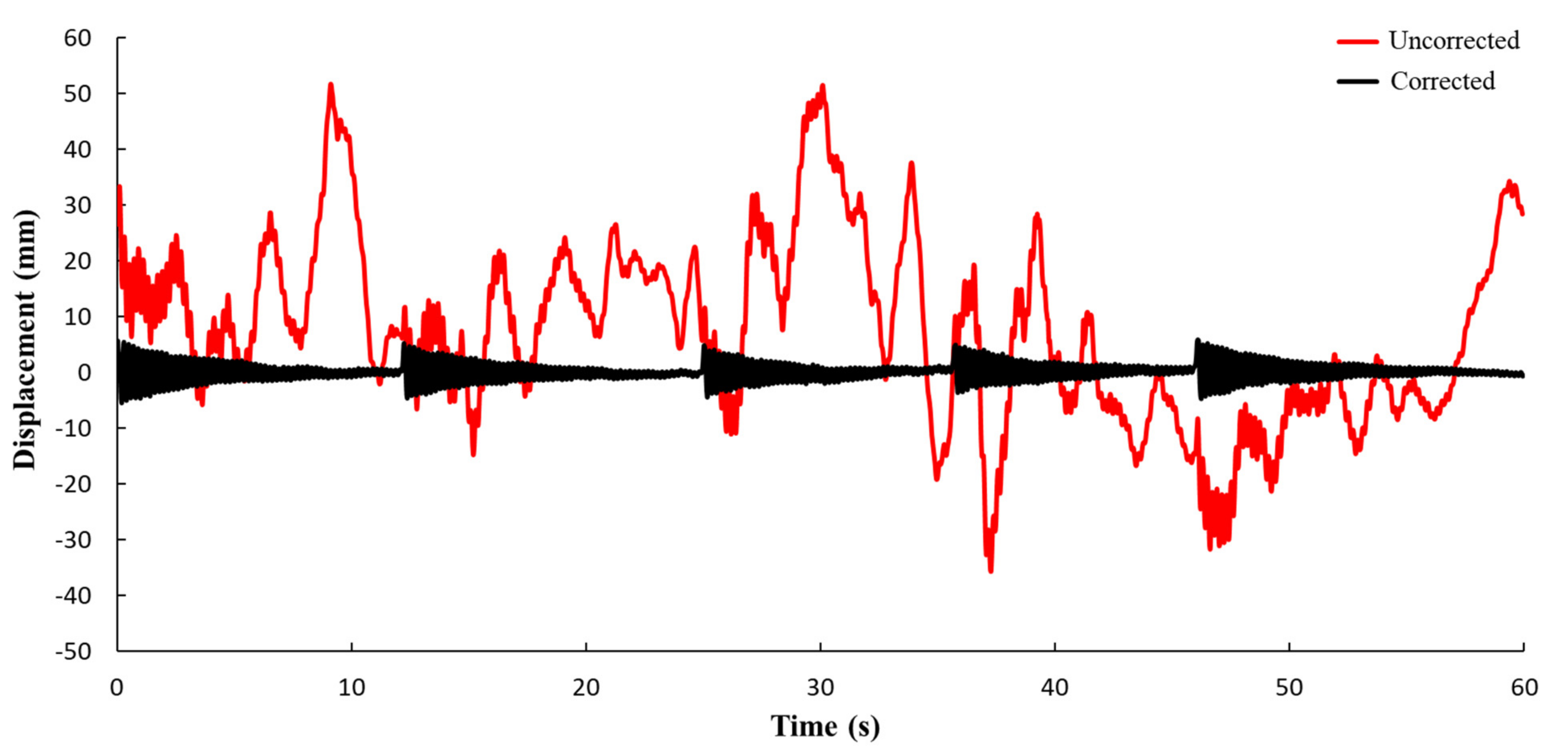
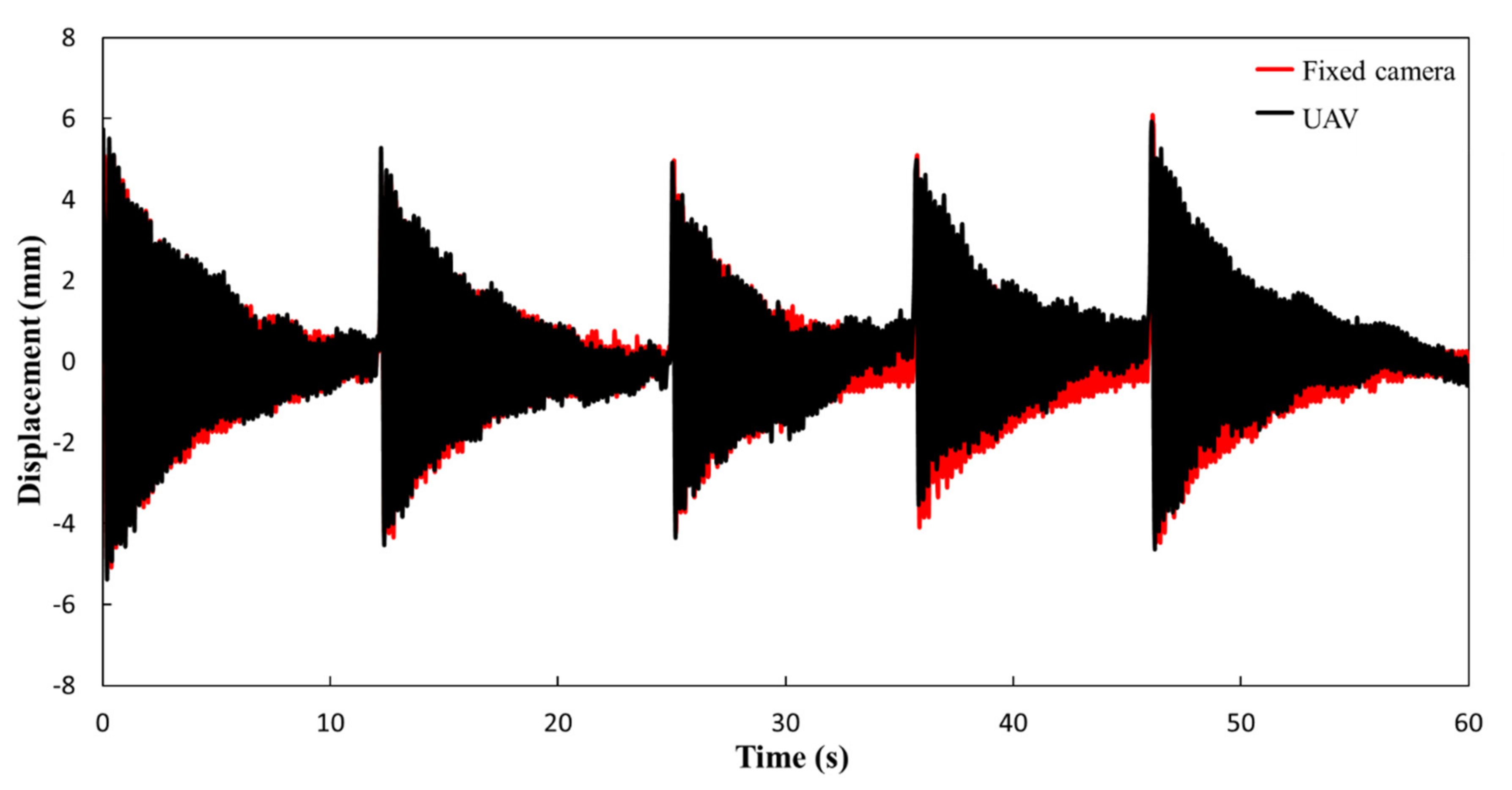
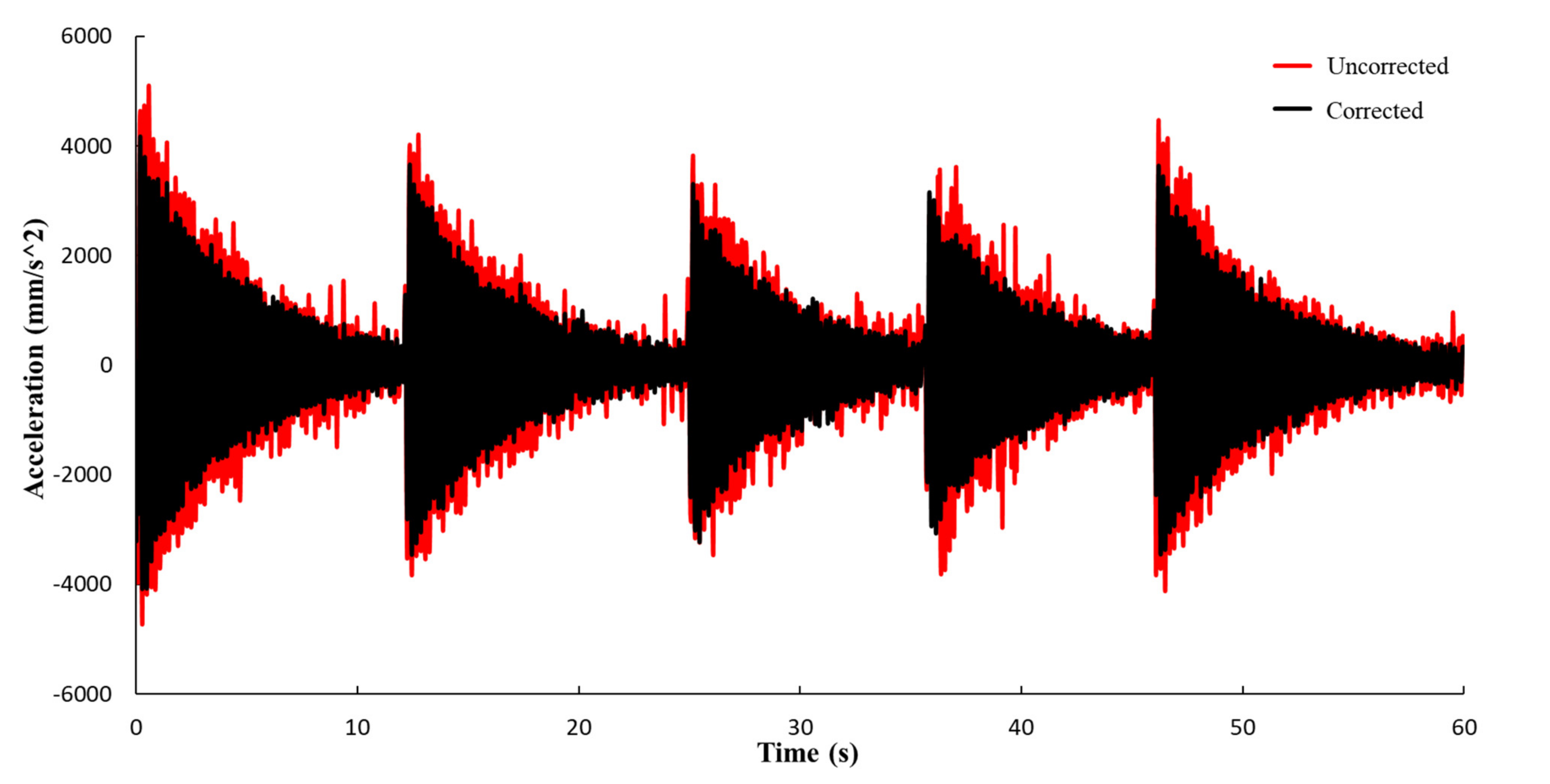

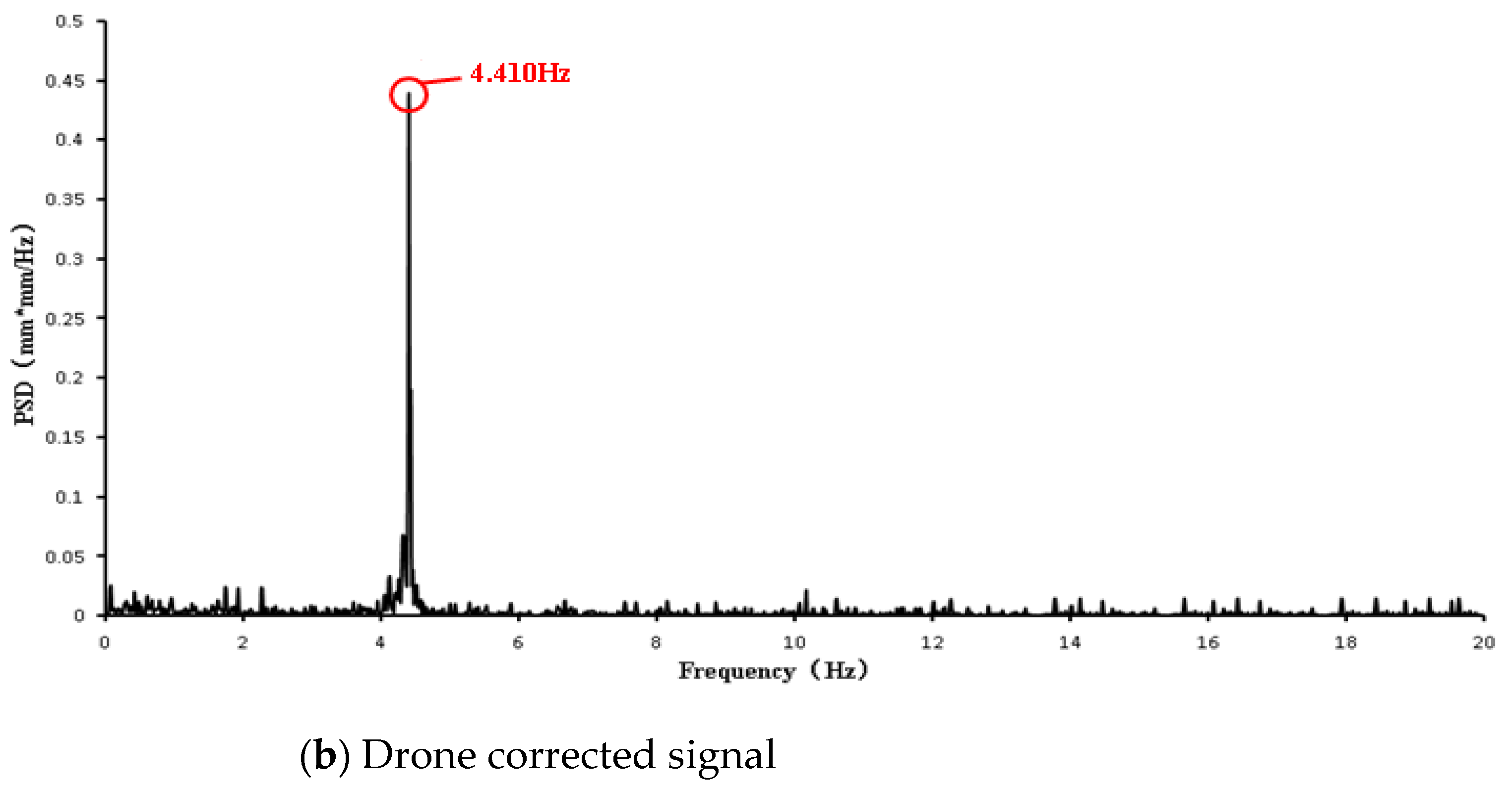
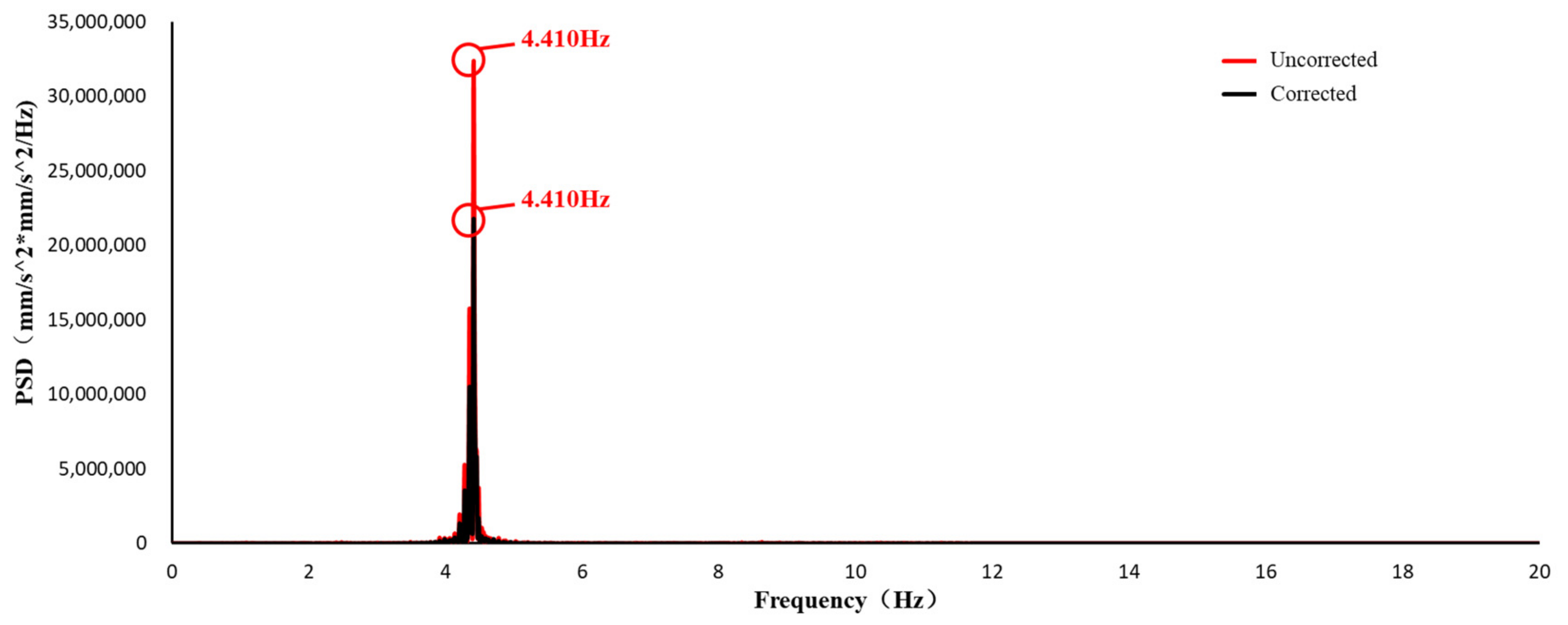
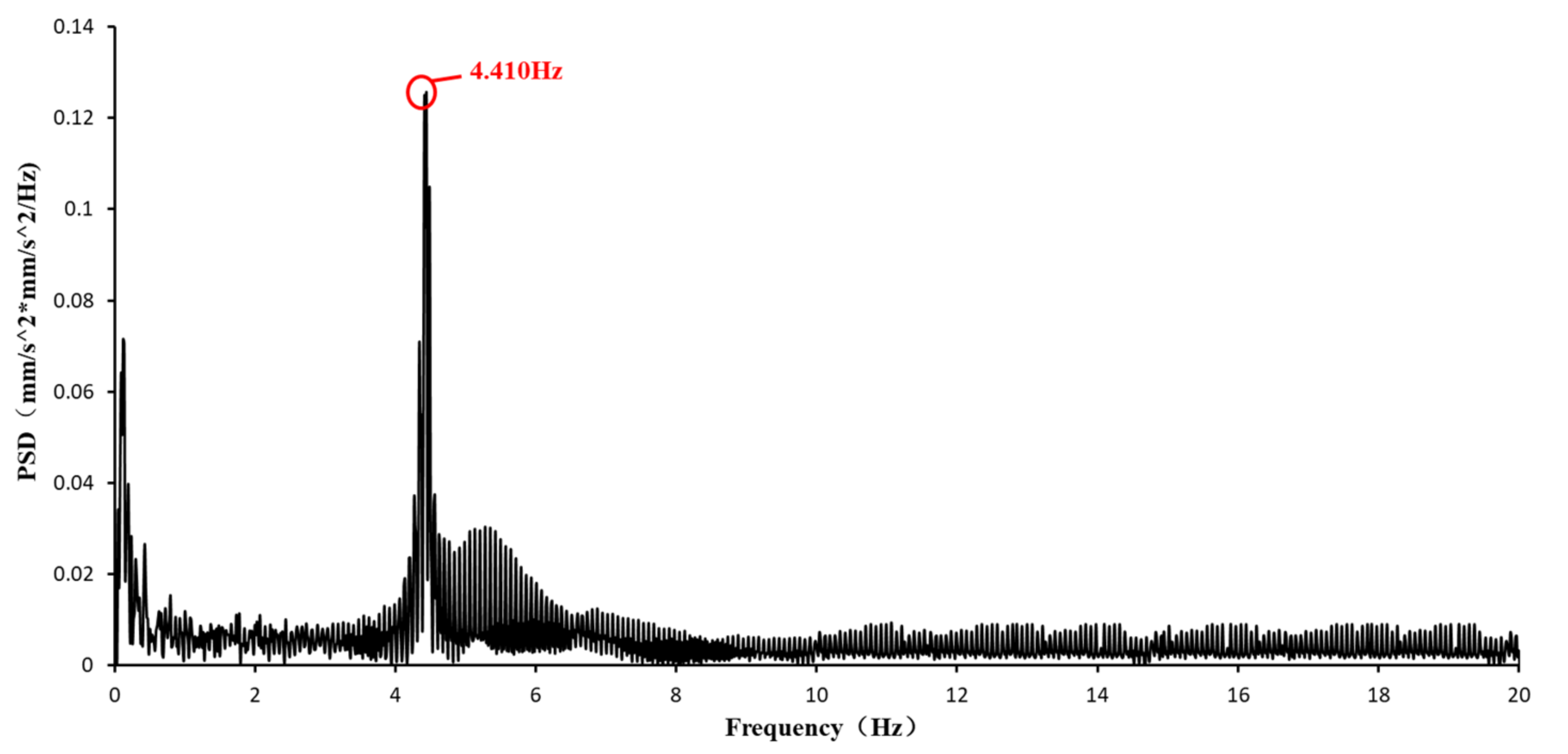
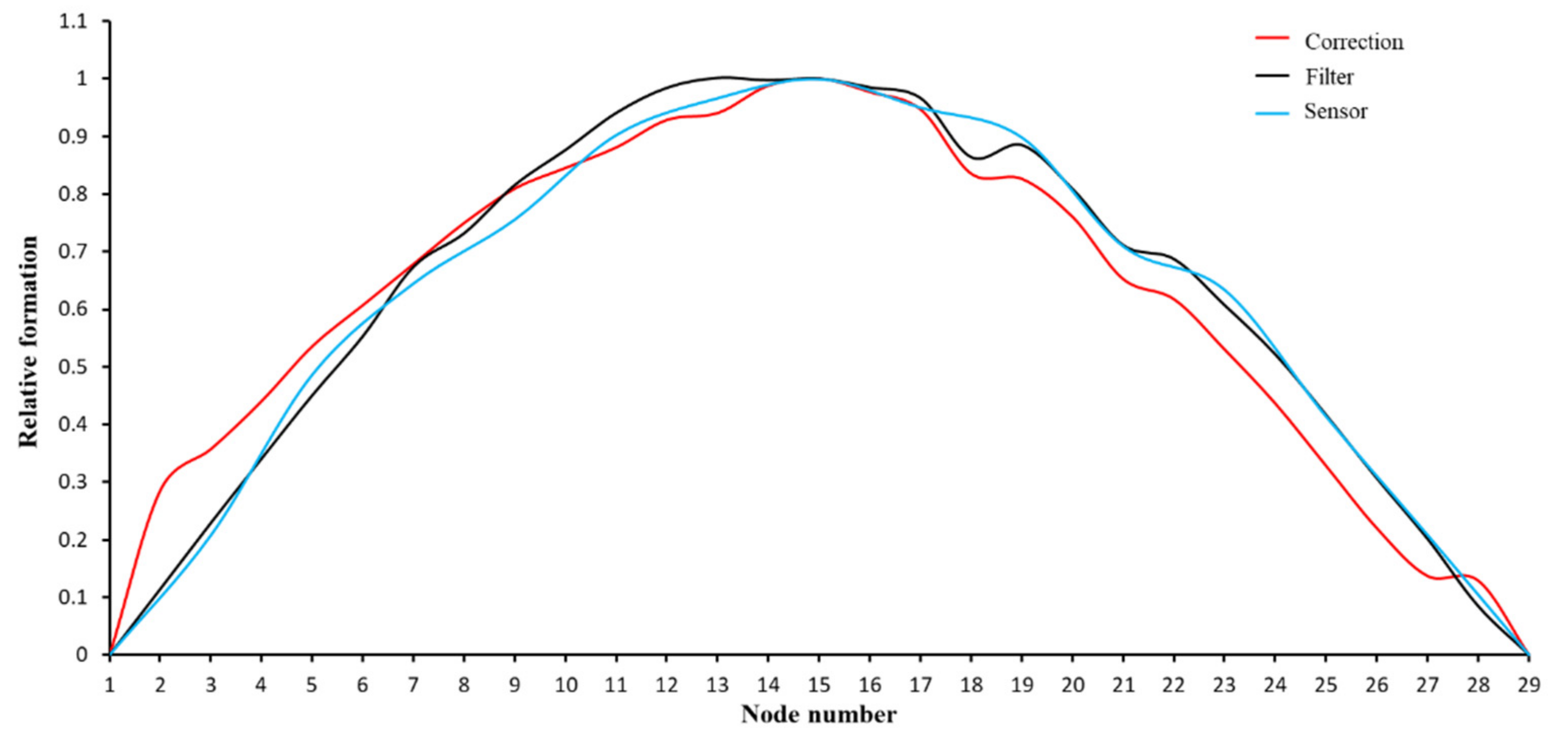
| Index | Peak Frequency | Extreme Value |
|---|---|---|
| Displacement | ||
| First-order derivative | ||
| Second-order derivative |
| Sampling Equipment | Sampling Frequency (Hz/s) | Resolution (Pixels) | Sampling Time (s) | Total (Frames) |
|---|---|---|---|---|
| Fixed camera | 2000 | 1024 × 1024 | 60 | 120,000 |
| Drone | 30 | 1920 × 1080 | 60 | 1800 |
| Accelerometer | 50 | / | 60 | / |
| Measurement Methods | Accelerometer |
UAV Correction 2nd-Differential |
UAV Original Signal with 2nd-Differential |
|---|---|---|---|
| First-order natural frequency | 4.410 Hz | 4.410 Hz | 4.410 Hz |
Publisher’s Note: MDPI stays neutral with regard to jurisdictional claims in published maps and institutional affiliations. |
© 2021 by the authors. Licensee MDPI, Basel, Switzerland. This article is an open access article distributed under the terms and conditions of the Creative Commons Attribution (CC BY) license (https://creativecommons.org/licenses/by/4.0/).
Share and Cite
Zhang, J.; Wu, Z.; Chen, G.; Liang, Q. Comparisons of Differential Filtering and Homography Transformation in Modal Parameter Identification from UAV Measurement. Sensors 2021, 21, 5664. https://doi.org/10.3390/s21165664
Zhang J, Wu Z, Chen G, Liang Q. Comparisons of Differential Filtering and Homography Transformation in Modal Parameter Identification from UAV Measurement. Sensors. 2021; 21(16):5664. https://doi.org/10.3390/s21165664
Chicago/Turabian StyleZhang, Jiqiao, Zhihua Wu, Gongfa Chen, and Qiang Liang. 2021. "Comparisons of Differential Filtering and Homography Transformation in Modal Parameter Identification from UAV Measurement" Sensors 21, no. 16: 5664. https://doi.org/10.3390/s21165664
APA StyleZhang, J., Wu, Z., Chen, G., & Liang, Q. (2021). Comparisons of Differential Filtering and Homography Transformation in Modal Parameter Identification from UAV Measurement. Sensors, 21(16), 5664. https://doi.org/10.3390/s21165664






